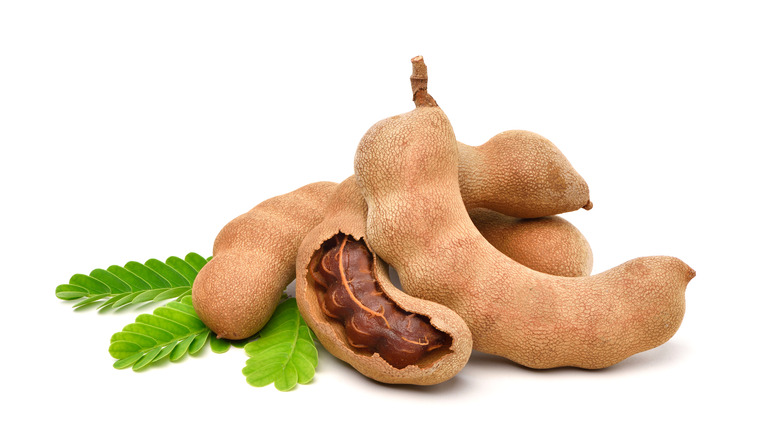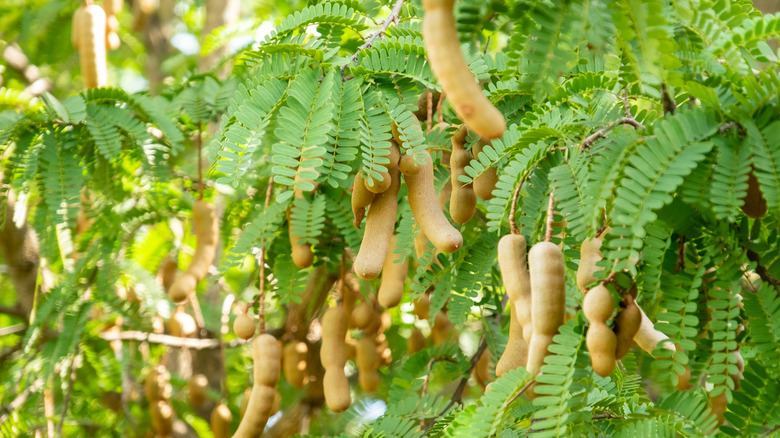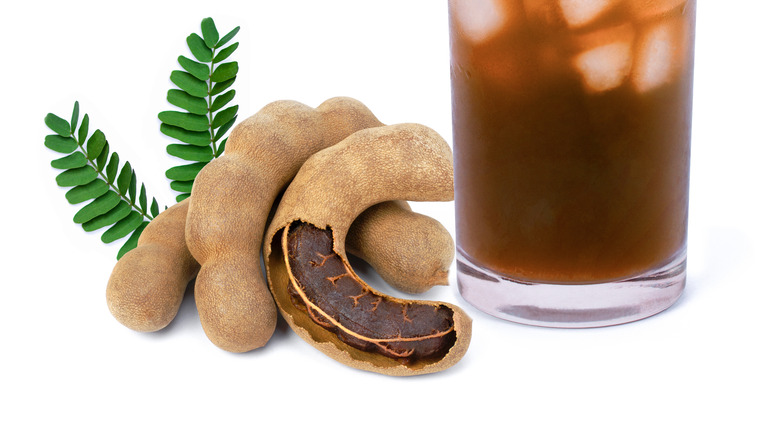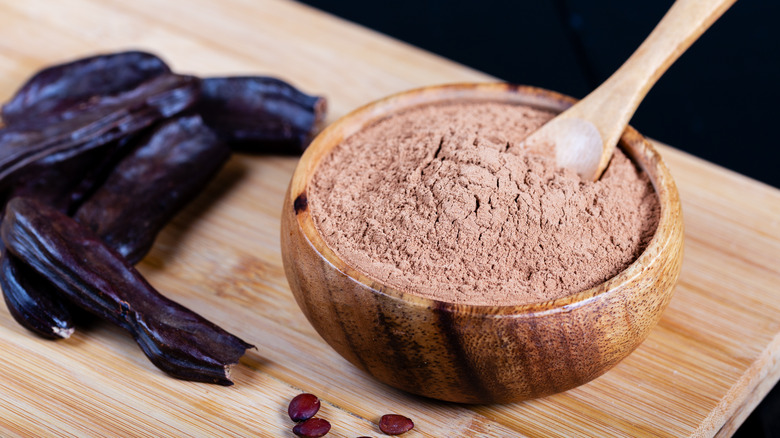What Is Tamarind And What Does It Taste Like?
You've surely heard of tamarind, but what do you really know about this versatile and fruity flavor? Native to tropical Africa, tamarind is derived from the Arabic tamar hindi, which loosely translated means "Indian date" (via Free Dictionary). Unlike a date, the tamarind requires a little more preparation than just eating it off the vine, but it's a unique taste that many consider worth any amount of effort. The tamarind tree's fruit can resemble a chocolatey-colored pea or bean inside a lighter-colored pod, but people will typically pick pods larger than that of most snap peas. The flavor of tamarind can be either sweet or sour, depending on how ripe the fruit is and what part of this highly utilized plant you are including in your food.
Even if you don't know it, you've probably tasted tamarind. The fruit is used commonly in Indian cuisine, such as chaats and curries, and is also used in Worcestershire sauce.
How tamarind grows
Tamarind grows from a tamarind tree (via Purdue). The tree is valued as an ornamental as well as for its flavorful and aromatic seed pods. Tamarind trees are slow-growing and long-lived but can reach heights of 80 to 100 feet. The trees produce subtle flowers that display before pods form, and pods can vary somewhat from reddish cinnamons to a deeper brown. A mature tamarind tree may produce between 300 to 500 pounds of pods, up to half of which may be the fruit interior.
Tamarind seeds (inside the pea-like hanging pods) have a date-like texture but a totally different taste, according to MedMunch. This pulp, seed, and paste are very sour when unripe and quite sweet when fully ripened, leading to its diverse range of flavor. MedMunch describes the result as a "tropical lemonade with a hint of caramel" noting that even at the sweetest, there's a tang that can creep up on you.
How to cook with tamarind
Think of tamarind a lot like you'd think of ginger or garlic. Tamarind can be eaten raw or used as a seasoning, as well as juiced, dried, pressed, or powdered. While you technically can, you probably won't want to eat tamarind plain. You'll easily find ripe and sweeter tamarind in dishes like red fish curry and lamb vadouvan curry or chaats like dahi vada, bhel puri, samosa, or kachori chaat as well as candies and drinks (via Bon Appétit). Most commonly this versatile ingredient can be found in Indian cooking as well as Southeast Asian and Central and South American cuisine.
Raw tamarind will usually make your mouth pucker, so it's most often used in pickling and chutneys, especially in its unripe, green form. Powdered tamarind is used both in cooked dishes as well as dusted atop snacks like peanuts for a tingly/sweet/sour experience. Paste, concentrate, or extract of the ripe fruit is used as a sweet-sour agent in chutneys and many meat dishes. Browned and ripened fruits are often used as a marinade for steak or fish. The fruit is used in many cases to balance flavors or add a mild sourness to dishes. Tamarind can tenderize meat or act as a food preservative. The specific flavor of tamarind depends on how you use it.
What does tamarind taste like?
MedMunch describes the taste of tamarind juice to an American palate as tropical lemonade with some caramel flavors. The flavor of tamarind by itself is likely something not common in most American cuisine, but the experience is still highly appealing.
One tamarind lover describes the experience of eating the fruit: "The sweet and sour taste of tamarind is just incredible," (via Instagram). The cook goes on to note, "The ripe ones, you can crack the shell to get to a jammy, tart, and sweet goodness. The greens ones are tart and astringent. You make amazing chutney with both kinds. We also cook with tender tamarind flowers and leaves. Tamarind flowers are called Chigur and we make daal and chutney with those." Which flavor of tamarind you'll like best is really a matter of taste, so it's important to know how to adjust to meet your palate. If you've followed a recipe but still find your tamarind a bit too sour, it's okay to add a little sweetener like sugar. If you prefer the more savory side of this flavor, tamarind pairs well with chiles, garlic, and ginger, but be warned that combining fresh herbs with tamarind can be too overpowering for the palate.
And while you might not be able to conjure up the taste of tamarind in your imagination, most will notice the lack of this key ingredient if it's withheld from your favorite curries or chutneys.
Nutritional information about tamarind
Tamarind has a long history of medicinal use, especially in Ayurveda, providing the necessary sour component of a healthy Ayurvedic diet. "Tamarind leaf paste aids in healing inflammation and sprains," Regi Mathew, co-owner and culinary director of Kappa Chakka Kandhari, told Bon Appétit. Mathew also noted that a tea brewed with tamarind can help with sore throats.
While detailed studies have not been performed on all claims, users have touted the benefits of tamarind for nausea, dry eyes, constipation, colds, fever, liver and gallbladder problems, assorted stomach issues, and even intestinal worms (via RXList). And while there may need to be more study to fully understand these benefits, experts generally recommend that consuming tamarind is likely safe in standard quantities. Experts can, however, verify that tamarind includes components like amino acids and B vitamins generally considered good for our health, per WebMD.
Where to buy tamarind
Buyers should be able to find fresh tamarind pods in most grocery stores that sell produce, even if there is not a large selection of the product. Tamarind is typically available in season from April to July for fresh pods, as Food 52 suggests. Buyers may have even better luck by searching at Indian, Latin, or Southeast Asian markets. If fresh tamarind is not available, look for pressed blocks of processed tamarind instead. Another product you may find in a shop is tamarind paste, which can be sold either fresh or frozen (via Thrive Cuisine). Many major grocery stores including Safeway, Walmart, and Whole Foods carry this tamarind product.
In addition to pastes and concentrates, you can order tamarind online in powdered form. The specific choice you make should reflect how you plan to use this widely versatile ingredient.





